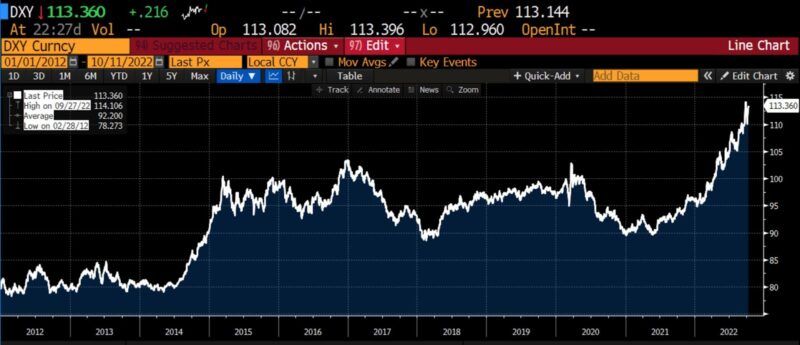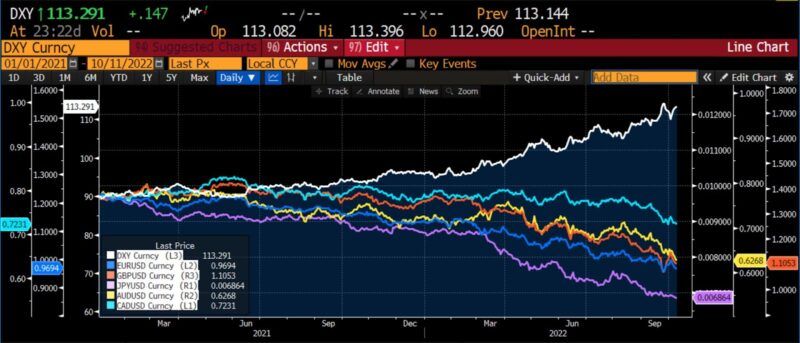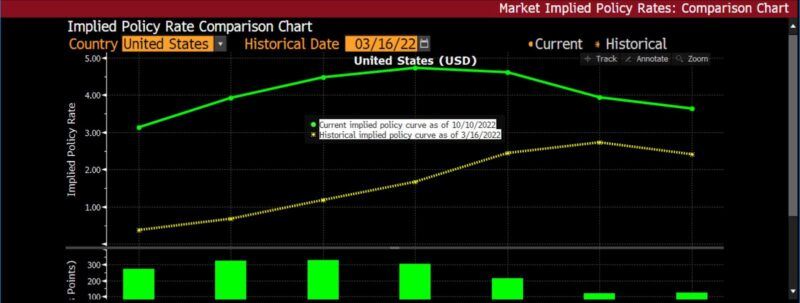

By Peter C. Earle
Behold, the dollar ascendant! Since June 2021, the greenback has been on a tear, recently reaching levels not seen since July 2002. In a year in which virtually every asset class has been hammered, US dollars (as measured by the DXY Index) are up over 16 percent as of October 1st. In fact, between September 12th and 26th alone it increased by over 5 percent. Because the dollar is the world’s reserve currency, and for a significant portion of global trade acts as the unit of account, the effects of the surge are being felt worldwide.
Despite jingoistic overtones, dollar strength brings clear tradeoffs for US citizens. The rapid appreciation of the dollar makes imports to the US cheaper and exports more expensive. So for US consumers, part of the blow currently dealt by inflation is mitigated. But for large firms selling American goods overseas, foreign domestic goods are likely to be more competitively priced. That may lead to declining revenue and job loss among US workers. Some firms choose to price goods sold in foreign markets in local currencies, adjusting prices to maneuver between retaining dollar-based revenue and profit without suppressing demand. But the current economic environment is creating difficulties beyond those that can be skillfully priced away or hedged with derivatives.
US Dollar Index (2012 – present)


Typically the standard response to a rocketing dollar (or any rapidly appreciating currency) is an import boom. Foreign producers would attempt to sell as much as possible in the US and other dollar-using economies. Over time those cheaper imports would outsell domestically-produced goods leading to slowing economic growth and a commensurately easing dollar. But at present there are major hindrances to that historic, equalizing process. Two and a half years after pandemic mitigation policies were put in effect, adverse effects linger. From supply chain bottlenecks to energy shortages to China’s ongoing Zero Covid policies, but mostly due to global inflation, the price signals that guide the flow of goods and services have been blunted. Relative price changes are more difficult for business managers and entrepreneurs to detect as the general price level rises, so getting products from one place to another has become subject to miscalculation, increased delays, and higher costs.
The strength of the dollar is attributable to both geopolitical tensions and the aggressive response of the Federal Reserve to the inflationary updraft which began in early 2021.
Indeed, capital flows to the US have increased. US dollars are extremely liquid and readily convertible into interest-bearing US government securities, securities upon which interest rates are currently rising.
A more accurate account of the latter cause, however, contrasts the Fed’s delayed policy reaction to rising prices as nevertheless superior to the slow (if indeed any) action taken by other central banks. The US central bank was characterizing the uptrend in prices “transitory” far longer than it should have, but began lifting rates in March 2022. With inflation in the UK (as measured by the UK CPI, headline year-over-year) surpassing 10 percent this summer, Bank of England head Andrew Bailey came under fire for raising rates slowly and at small increments and with little urgency. Similarly, the European Central Bank’s main policy rate, the Deposit Facility Rate–negative since 2014–was raised to 0 percent in July 2022, then to .75 percent in mid-September 2022. The Bank of Japan’s Policy Rate (Balance) has for years been and remains fixed at .10 percent.
Central Bank Policy Rates of US Federal Reserve, Bank of England, Bank of Japan, and European Central Bank (2018 – present)


So in addition to the perception of the dollar as a safe asset, the reluctance of major central banks to combat inflation aggressively is driving the dollar up in value. Another, likely lesser source of demand are pariah states. Having seen the effects of Russia’s being pushed out of certain dollar-based payment systems, it is likely that some stockpiling of dollars has taken place.
There is a rub to all of this, though. Complaints from other nations have been growing. These may lead to protectionism, currency interventions, or both. In September the Japanese government undertook a $19.7 billion defense of the yen. Domestically, the mightiness of the US dollar–a direct effect of Fed policies–may undermine them. More affordable imports may spill over into domestic goods and services, which alongside lower (while still elevated) gasoline prices may feed demand at a time when the Fed is actively working to diminish it.
US Dollar Index vs. EURUSD, GBPUSD, JPYUSD, AUDUSD, CADUSD (2021 – present)


Which raises a question for the near term reign of King Dollar. Will foreign governments, the US Treasury, the Federal Reserve itself, or a coordinated effort between all of them snatch away his crown?
At present it seems unlikely. Beyond jawboning, the Fed has demonstrated its commitment to fighting inflation. The series of 75 basis point “jumbo” rate increases makes an effort to weaken the dollar in the near term improbable. When the last purposeful effort to weaken the dollar was undertaken in 1985 (the Plaza Accord), it was facilitated by declining interest rates and disinflation.
On the other hand, a look at the shift in market expectations regarding the future direction of interest rates between the Fed’s first rate hike (on March 16, 2022) and last week is noteworthy. Setting aside the level of rates, in March traders believed (yellow dotted line, below) that the Fed would raise rates for two years, but that by March 2025 rates would be back on the decline, lower than the highest level of the hiking cycle. The shape of the market-implied rate curve last week (green line) tells a different story: Market participants now believe that Fed policy rates will reach their high in just six months (April 2023) before being lowered again.
Market Implied Policy Rates, 3 mo – 3 year


Whether the Fed pivots away from its inflation fight or not, other central banks are far behind the curve. That is likely to keep the dollar at the top of the global currency pecking order. The growing intensification of the Russo-Ukrainian War is also likely to sustain the demand for dollar-denominated assets. With continuing dollar appreciation the likelihood of trade tensions and protectionism increase, as do the possibilities of organized labor agitation. King Dollar is secure for now, but as in all palaces – intrigues persist.




